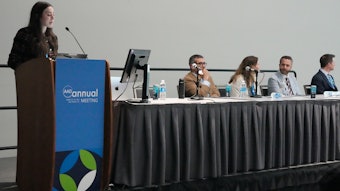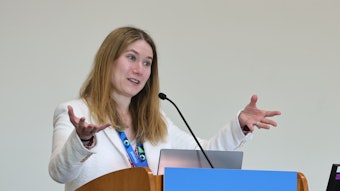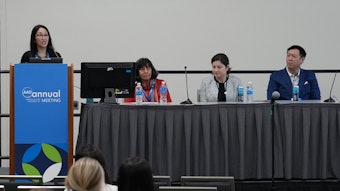Changing the course of cancer care
The 2024 Lila and Murray Gruber Memorial Cancer Research Award and Lectureship hails advancements in chronic myeloid leukemia treatment.

“Breakthroughs require knowledge and seeing things differently. Everyone says, ‘You’ve got to think outside the box.’ But sometimes the answer is right there in front of you. You’ve got to say, ‘It’s a box,’” said Brian Druker, MD, director of the OHSU Knight Cancer Institute in Portland, Oregon, who delivered the Lila and Murray Gruber Memorial Cancer Research Award and Lectureship during the March 10 session, P151 – Plenary.
The research award encourages participation in cancer research and provides a forum for the enrichment of knowledge of dermatologists in this important scientific field. Dr. Druker was honored for his research that led to the development of imatinib (gleevec), a targeted cancer therapy that has transformed the treatment of chronic myeloid leukemia (CML).
Developing a breakthrough drug
CML, a type of cancer that starts in the blood-forming cells of the bone marrow, is responsible for 15-20% of leukemias in adults, with one to two cases per 100,000 per year. The rare disease typically affects adults in midlife, with an average age of onset between age 50 and 60, although it can occur at any age. Until the development of imatinib, the first drug to specifically target the BCR-ABL tyrosine kinase protein, patients with CML had a median survival of just three to five years. Now, almost all CML patients — 95% — respond to treatment with imatinib and are alive after five years, Dr. Druker said.
During his presentation, Dr. Druker mapped out the molecular pathogenesis of CML, the role of BCR-ABL, the specific chromosomal abnormality that’s responsible for the molecular abnormality of CML, and how imatinib inhibits CML by blocking tyrosine kinase. This acts as a chemical messenger to incite the growth of cancer cells.
“BCR-ABL is present in all patients with CML and a therapeutic target because it causes the molecular abnormality of CML. Tyrosine kinase activity of BCR-ABL is required for the diseased cells to function,” Dr. Druker said.
Dr. Druker noted that early detractors didn’t think kinase inhibitors would work as targets for CML for a variety of reasons, including a lack of specificity, the potential for toxicity, and a lack of downstream profit to justify their development. But pre-clinical and clinical trials showed that imatinib selectively killed BCR-ABL-expressing cells in vitro and in vivo.
“We learned from clinical trials with imatinib that a good therapeutic target plus a good drug equals good results,” Dr. Druker said. Imatinib is the current standard therapy for CML.
The future of cancer treatment
The success of imatinib can translate to other malignancies, including melanoma driven by KIT gene mutations. The secret sauce: Identifying the appropriate therapeutic targets, treating early in the course of the disease, and matching the right patient with the right drug, Dr. Druker said. Cancer is currently treated by site of origin, such as breast, colon, lung, and prostate; treatment is largely empiric and toxic; response rates are relatively low, and the patients who will respond often unpredictable, he said. In the 21st century, Dr. Druker predicted that cancer treatment will take a more broad-based approach, including developing specific therapies directed at critical targets coupled with early diagnosis to improve outcomes.
“Because of the work we do in laboratories and clinics, my hope is that we’ll see thousands of patients surviving and thriving despite a diagnosis of cancer,” he said. “One of my patients with CML recently celebrated 25 years on imatinib therapy.”











